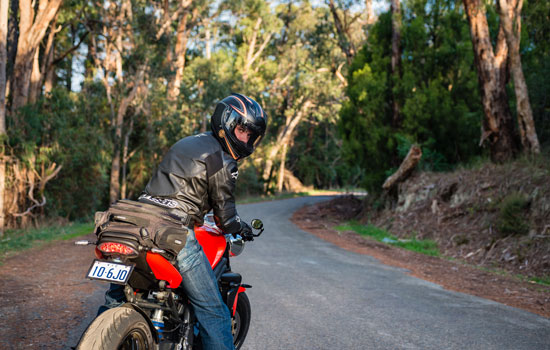Learning to ride a motorbike or returning to riding? Find out how to get your motorbike licence and if your off-road bike needs to be registered. Tips on this page will enhance your riding techniques, outline motorbike maintenance and explain the pre-ride checks to make before each ride.
MOTORCYCLE LICENCES
Starting to ride
Riding a motorcycle takes more practise and involvement than driving a car.
Returning to riding
Refresh your riding skills to enjoy today’s bikes. They handle differently.
Off-road riding
Off-road motorbikes need registration as recreational or farm bikes if they leave private property.
Skills
On the road, your riding skills are your biggest assets. Advanced riders and trainers are generous in sharing tips and it’s worth seeking out advice. Here are several suggestions here to get you started.

Cornering and curves
Every curve is different and enjoyable. Master the basics of counter-steering with a professional trainer. Decelerating before corners gives you time to see and react to hidden hazards.
Riding curves and corners
Braking needs practise
Practise braking on your own bike with a professional trainer. Riding with a three second gap between vehicles gives you time to react to the unexpected.
Find an accredited trainer
Group rides
Group rides with trainers and clubs are an excellent way of getting feedback and advancing your skills. Stick to speeds you’re comfortable with and always ride within your ability.

Lane filtering
Riding between vehicles moving in the same direction is legal in Victoria for licensed riders (not learners) where it is safe to do so and the motorbike speed is under 30km per hour.
Lane filtering guidelines
Position to be seen
The best road position varies according to the number of traffic lanes. On single lane roads, riding in the right-hand wheel track is the motorbike position most visible to drivers.
Victorian Rider Handbook download
Keeping away from trouble
Keeping other vehicles at a safe distance creates survival space if the unexpected happens. Be prepared to slow down entering intersections, where turning cars might cut you off.
More tips for dealing with traffic
Anticipating others in traffic
One aspect of riding safely is observing and anticipating what other vehicles may do next. Remember the ‘lifesaver glance’ over your shoulders to see what's behind you.

Carrying a pillion passenger
Explain to your pillion how to mount and keep their feet on the pegs (avoiding the exhaust), how to hold on and how to communicate with you. They need a helmet chosen specifically for them to keep them safe and protective gear.
Rules for carrying pillions
Alertness and avoiding fatigue
A motorbike doesn’t forgive a lapse in concentration. Only you can monitor if you’re alert enough to ride. Plan breaks at least every two hours on long rides.
Download The Right LineYour gear kit
Choosing quality gear that suits you is as important as choosing your dream bike. Online reviews and YouTube may offer valuable tips from other riders who have crashed with and without protective motorbike gear.


Be prepared to buy quality gear for protection
Know what to look for in gear and buy the safest you can afford. It’s an investment in your own skin that can stop you from being shredded by bitumen. Wear all the gear every time the bike leaves the driveway, even for short trips.
Safety gear for street riding includes an approved helmet (a legal requirement in Australia), a jacket with armour, pants with armour, boots and gloves. A full-face helmet gives the best protection.
Off-road safety gear includes an approved full-face helmet (a legal requirement in Australia), eye protection, off-road body armour, knee guards, boots and gloves.
SPOKES buying guideBikes
Each bike handles differently. Choose a bike based on its fit with your needs, rather than choosing by brand. Look for a model that offers the added benefits of ABS, linked brakes, Motorcycle Stability Control (MSC) and traction control.
Maintenance
Maintenance is key to keeping your motorbike running smoothly. Check over your bike at home regularly, and take it to an expert for an in-depth tune up.
Pre-ride checks
Even if your bike is pretty new, it’s a good idea to check out its condition before each ride. Refer to a handy checklist that includes brakes, tyres and lights.
Rides and recommendations
Long touring rides can be demanding, particularly in difficult weather, so it's worth having regular breaks. It's also worthwhile giving your motorbike the once-over before you leave home or getting someone in the know to do it for you. Checking the weather will help determine the gear to take with you.
Tight corners and traffic
The best rides for motorbikes are popular with tourists. Be wary on tight corners because oncoming traffic is likely.
Centre lines
Take a wide line until you see through each corner and keep your head well within your side of the centre line.
Forest rides
Watch out for slippery moss between car tyre marks and for loose stones on winding roads with gravel road shoulders.
If you're injured
Call an ambulance if you're injured. The TAC covers all classes of registered motorbikes, including injuries that occur off-road.
Cornering
- Watch for rock slides, loose gravel, oil, diesel, water across the road and wildlife.
- When cornering, the most important factor is to enter at a safe speed.
- Be prepared to judge a safe speed entering extreme road cambers, double apexes and double back corners.
- If you accelerate into, or brake late into a corner, you may not recover from the error.
Plan ahead, even if it’s just a chat with fellow riders about rest spots, a weather check and a pre-ride check of your bike. If you’re riding alone, always let someone know your plan.
Recommended rides
Troy Bayliss on safety
